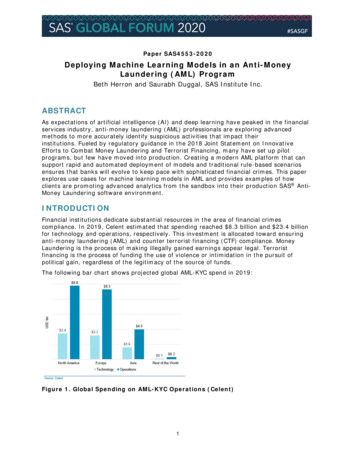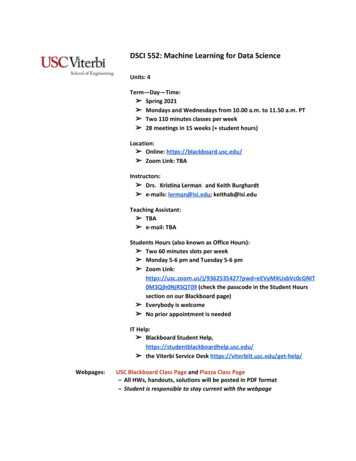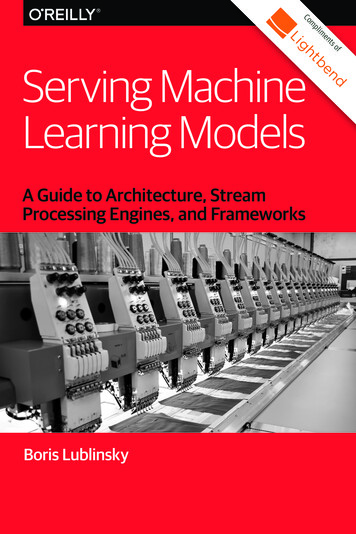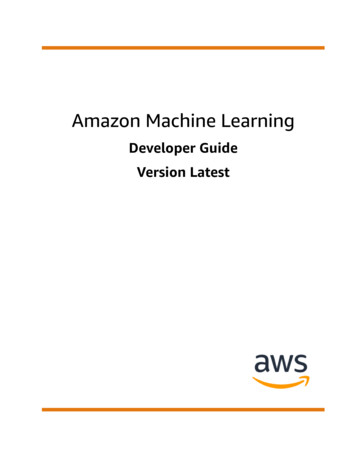
Transcription
Paper SAS4553-2020Deploying Machine Learning Models in an Anti-MoneyLaundering (AML) ProgramBeth Herron and Saurabh Duggal, SAS Institute Inc.ABSTRACTAs expectations of artificial intelligence (AI) and deep learning have peaked in the financialservices industry, anti-money laundering (AML) professionals are exploring advancedmethods to more accurately identify suspicious activities that impact theirinstitutions. Fueled by regulatory guidance in the 2018 Joint Statement on InnovativeEfforts to Combat Money Laundering and Terrorist Financing, many have set up pilotprograms, but few have moved into production. Creating a modern AML platform that cansupport rapid and automated deployment of models and traditional rule-based scenariosensures that banks will evolve to keep pace with sophisticated financial crimes. This paperexplores use cases for machine learning models in AML and provides examples of howclients are promoting advanced analytics from the sandbox into their production SAS AntiMoney Laundering software environment.INTRODUCTIONFinancial institutions dedicate substantial resources in the area of financial crimescompliance. In 2019, Celent estimated that spending reached 8.3 billion and 23.4 billionfor technology and operations, respectively. This investment is allocated toward ensuringanti-money laundering (AML) and counter terrorist financing (CTF) compliance. MoneyLaundering is the process of making illegally gained earnings appear legal. Terroristfinancing is the process of funding the use of violence or intimidation in the pursuit ofpolitical gain, regardless of the legitimacy of the source of funds.The following bar chart shows projected global AML-KYC spend in 2019:Figure 1. Global Spending on AML-KYC Operations (Celent)1
Traditional methods of combating financial crimes are not keeping pace with the disruptionoccurring in the banking and financial sector. Faster payments, digital first strategies andthe ever-rising cost of compliance are accelerating the change. Fueled by regulatoryguidance in the 2018 Joint Statement on Innovative Efforts to Combat Money Launderingand Terrorist Financing (Federal Reserve), many have set up pilot programs, but few havemoved into production. Some innovation barriers observed within financial crimescompliance are: Limited Data Science skills Difficulty in explaining machine learning models Lack of integration capability with incumbent systemsWith the help of SAS Financial Crimes Analytics, everyone is enabled to build explainablemachine learning models (including data scientists, business analysts, and developers) andoperationalize so that the investigators can act quickly.MACHINE LEARNING STRATEGIESFinancial institutions have been leveraging automated transaction monitoring strategies tocombat money laundering for years, but machine learning techniques are gaining traction.Machine Learning is based on the idea that systems can learn from data, identify patterns,and make decisions with minimal human intervention. The most commonly used branchesof machine learning are supervised and unsupervised learning.SUPERVISED LEARNINGSupervised learning algorithms are trained to detect money laundering that leverage knownhistorical outcomes. For example, the automated transaction monitoring rules that are runtoday are generating alerts reviewed by investigators. The machine can leverage thesuspicious activity report (SAR) flag (‘yes’ or ‘no’) to predict future outcomes by consideringcomplex relationships in the customers behavior.UNSUPERVISED LEARNINGUnsupervised learning techniques leverage unlabeled data, learning from the structure ofthe data itself. In this case, there is no historical outcome or “right answer” to learn from.For example, client populations can be segmented into peer groups in order to understanddeviations in their activity.USE CASES IN AMLMachine learning can be valuable in improving the efficiency and effectiveness of your antimoney laundering program. In most cases, machine learning is augmenting rather thanreplacing traditional transaction monitoring methods. Below are several examples of usecases where banks are leveraging these techniques today: Segmentation – Transaction monitoring scenarios can generate high false positiverates due to the use of thresholds. To mitigate operational risk, thresholds are oftenset high, creating alerts that are disproportionately skewed toward high dollartransactions. As a result, an activity that is worth a review might be sitting below thethreshold. Leveraging a behavior-based approach, customer groups can be createdusing unsupervised techniques. Transaction monitoring scenarios can then besegment aware, having different thresholds that are based on each customer group.The resulting effects are lower false positives and greater coverage of activity thatwas hiding ‘below the line’.2
Alert Scoring and Hibernation – Anti-money laundering typologies are oftentemporal in nature, making it difficult to identify on the basis of a single transactionor alert. Money laundering involves the layering of funds to officiate its source. Manyalerts are closed during the triage phase of the investigations process due to lack ofevidence. By aggregating alerts together, we can continuously risk rate customeractivity to determine when it becomes investigations worthy. At that time, the groupof alerts is promoted to case and valuable investigative resources are focused on theriskiest behaviors. Scenario Replacement – More progressive financial institutions have replacedseveral transaction monitoring scenarios with one machine learning model.Typologies that have historical case outcomes are well defined and result in highfalse positives and are generally the best candidates. In this paper, we will explorereplacing Cash focused scenarios with a machine learning model.EXAMPLE FRAMEWORK LEVERAGING SAS FINANCIAL CRIMESANALYTICSThis paper explores the process of building, registering and deploying a machine learningmodel to replace transaction monitoring scenario(s). To demonstrate the framework, we willleverage SAS Financial Crimes Analytics as the underlying technology. SAS FinancialCrimes Analytics provides end-to-end capabilities, from data to decisioning. Data Acquisition – Data is acquired from the SAS Anti-Money Laundering data modeland loaded into the SAS Financial Crimes Analytics environment. Feature Engineering – Data is joined to create a customer centric view withtransactional, non-transactional, demographic, and other relevant features to create abase table for modeling. Automated Model Development – Machine Learning models are created leveragingthe Automated Pipeline Generation feature. Model Management and Governance – The champion machine learning model isregistered in a centralized repository. Alert Generation – Output from the machine learning model is assessed with a cutoffscore to determine at what threshold to generate an alert. The decision flow is tested,then deployed to SAS Anti-Money Laundering using the alert API. Investigations – Output from the machine learning model becomes actionable forinvestigations.DATA ACQUISITIONThe SAS Anti-Money Laundering solution has a robust data model that links a wide varietyof transaction, non-transaction, and demographic dimensions to the entity (“Customer”) orexternal entity (“Customer’s Customer”). This data is rich in information such as theprimary instrument, secondary instrument, beneficiary, channel, branch, and other potentialfeatures that can be used to predict suspicious activity. The solution also housesinformation related to the disposition of prior investigations. Because information related toanti-money laundering programs are not publicly available, we have populated the SAS Anti-Money Laundering data model with fictitious data to illustrate the framework.This diagram shows the SAS Anti-Money Laundering conceptual data model:3
Figure 2: SAS Anti-Money Laundering Core Dimensional ModelFEATURE ENGINEERINGAfter loading the data, the first step is to transform the raw data collected from the SAS Anti-Money Laundering core dimensional model and create a base table for our modeldevelopment. Transaction monitoring scenarios typically leverage 5 to 7 parameters, butmachine learning techniques can consider many more features to more accurately identifypatterns. We identified 50 potential features that were indicative of Cash related behaviorsbased on the FFIEC guidance (Federal Financial Institutions Examination Council) anddomain knowledge. Next, the label (or target) was identified as “Good Alert” thatrepresents alerts which were promoted from triage to case for cash typologies. Thisinformation was aggregated to the customer level in order to identify cross accountbehaviors such as Cash Structuring.Display 1 shows the base modeling table created:Display 1: Data ProfileMODEL DEVELOPMENTOnce the base modeling table is created, the second step is to create a new project. Inorder to accelerate our model development process, the automated pipeline generationfeature was leveraged. This process automates iterative model development process,creating a dynamically generated pipeline from the input data. Once created, we will reviewthe champion and challenger models, expose the underlying settings, parameters, andcode. Though the system is creating the pipeline for the user, the model developmentprocess is not a black box and can be edited.4
Display 2 shows settings to create an automatically generated pipeline:Display 2: Automatically Generate the PipelineOnce executed, a pipeline is created automatically based on the data that is provided. Thesystem is intelligently determining the transformations and features needed to identify thebest solution. Through an iterative process, models are assessed, hyper-parameters aretuned, and ensembles are created to predict the outcome of “good alert”.Display 3 shows the steps in real time as the pipeline is being created:Display 3: Pipeline is Being Intelligently BuiltOnce complete, the pipeline is displayed showing the nodes generated including variable imputation,feature selection, and models. Many modeling techniques will be executed in order to identify achampion model. Keep in mind that with different input data, the pipeline generated will be different.5
Display 4 shows the pipeline that was automatically generated:Display 4: Automatically Generated the PipelineThe automatically generated pipeline includes a model comparison node, which compareseach technique to determine which model was best at predicting past cash activity and waspromoted from triage to case. Based on misclassification rate, the Gradient Boosting modelwas selected as the champion.Display 5 shows the results of our automatically generated pipeline:Display 5: Model Comparison ResultsModel documentation is automatically generated in a project summary report called aninsight. Insights provide details for the project such as project summary created usingnatural language generation, model assessment, cumulative lift for champion model, mostimportant variables for champion model, and many other key visualizations.6
Display 6 shows a sample of the model assessment results:Display 6: Model Assessment ResultsMODEL MANAGEMENT AND GOVERNANCEOnce you have identified your champion model, register the model. Registration of themodel provides four benefits:1. Organization and Management of Models: A centralized repository allows users tocapture data and model lineage in one place, compare open source and SAS models,and create life cycle templates to expedite deployment.2. Test and Validate Models: Evaluate whether the models were performant againstinvestigative results to determine if they are capturing the money laundering behaviorsintended in the definition.3. Publish: Automatically deploy in batch, streaming, or cloud. For our example, we willleverage the integration with SAS Decision Manager to ultimately create an alert workitem.4. Monitor Performance over Time: Performance monitoring and alerting automate themodel updating process to address model degradation.7
Display 7 shows registration of the new model:Display 7: Registering the ModelALERT GENERATIONTo derive value from our registered machine learning model, it is required to determinewhen to create an alert for investigations to review. A decision flow can be designedleveraging the drag and drop decision authoring interface. This flow automatically assessesthe output of the machine learning model and leverage rules to determine when to generatean alert. Decisions can range from simple to complex. To illustrate the framework, we willcreate a simple flow which creates an alert if the event probability from the model hasexceeded a cut off score.Display 8 shows the decision flow for creating an alert:Display 8: Decision FlowBased on the preceding flow, if the customer receives an event probability score of above.05, we structure the variables required for the SAS Anti-Money Laundering Solution, sendthe alert via API and document each record with a message that indicates if an alert wasgenerated or not. Next, you test the decision flow to ensure it is working as intended. Theresults can be reviewed to determine the operational impact, rules fired, and the alerts thatwould be generated once we publish.8
Display 9 shows testing of the decision flow:Display 9: Testing Decision FlowOnce the decision flow is tested and validated, publish the flow. There is an option ofmanually publishing on demand or scheduling the flow to run automatically.Display 10 shows publishing the flow:Display 10: Publishing the FlowINVESTIGATIONSAfter the alerts have been published, they are available in SAS Anti-Money Laundering forinvestigators to act. The alerts can now be searched, triaged, and investigated todetermine if a regulatory report is required. The alerts generated by the newly created cashmachine learning model are grouped with other alerting channels, such as transactionmonitoring and human rereferrals, so that analyst can have a compressive review of theentity. Lastly, you can surface descriptive and understandable reasons as to why the alertswere created to assist investigations in reaching a decision.9
Display 11 shows alerts generated in SAS Anti-Money Laundering:Display 11: SAS Anti-Money Laundering HomepageCONCLUSIONThere is a lot of excitement in the Financial Crime and Compliance industry around theapplication of machine learning techniques. We see many opportunities available today toapply these methods to improve the efficiency and effectiveness of AML and KYC programs.Replacement of low performing high volume transaction monitoring scenarios can be anarea where machine learning techniques can provide significant value, freeing up resourcesto focus on investigation worthy activity. With SAS Financial Crimes Analytics, banks cancreate, manage, and publish machine learning models rapidly within an integratedframework.REFERENCESBoard of Governors of the Federal Reserve System, Federal Deposit Insurance Corporation,Financial Crimes Enforcement Network, National Credit Union Administration, and Office ofthe Comptroller of the Currency. 2018. “Joint Statement on Innovative Efforts to CombatMoney Laundering and Terrorist Financing” Available eleases/files/bcreg20181203a1.pdfFederal Reserve Bank of St. Louis. 2012. “Economic Research.” Accessed November 7,2019. http://research.stlouisfed.org.Ray, Arin. and Katkov, Neil. 2019. “IT and Operational Spending in AML-KYC A GlobalPerspective.” CELENT.ACKNOWLEDGMENTSThe authors would like to thank Charlotte Crain and Mason Wheeless for their technicalguidance and thought leadership.10
CONTACT INFORMATIONYour comments and questions are valued and encouraged. Contact the author at:Beth HerronSAS Institute, Inc.Beth.Herron@sas.comFraud and Security Intelligence DivisionSaurabh DuggalSAS Institute, Inc.Saurabh.Duggal@sas.comFraud and Security Intelligence DivisionSAS and all other SAS Institute Inc. product or service names are registered trademarks ortrademarks of SAS Institute Inc. in the USA and other countries. indicates USAregistration.Other brand and product names are trademarks of their respective companies.11
Figure 2: SAS Anti-Money Laundering Core Dimensional Model FEATURE ENGINEERING After loading the data, the first step is to transform the raw data collected from the SAS Anti-Money Laundering core dimensional model and create a base table for our model development. Transaction monitoring scenarios typically leverage 5 to 7 parameters, but











